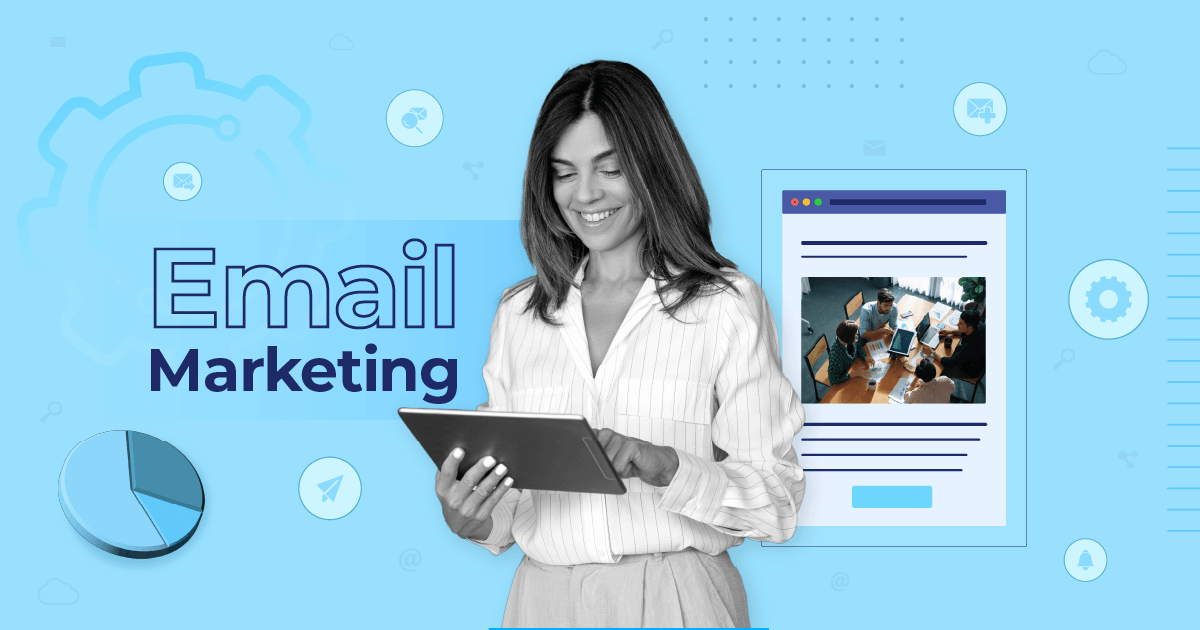
Email Marketing vs SMS Marketing: Which Works Best in 2025
Email marketing vs SMS marketing, which one should you bet on?
Both channels can drive sales, build loyalty, and keep your brand top of mind. But they work differently and knowing when and how to use each can make a real difference.
Whether you’re launching a new campaign or rethinking your cross-channel strategy, choosing the right one matters.
In this guide, we’ll compare email and SMS side by side to see which performs better, when to use each, their pros and cons, whether choosing one over the other is really the best move, or if there’s a better solution.
What is Email Marketing?
Email marketing is a digital strategy that involves sending targeted messages to a group of recipients via email. It’s used by businesses of all sizes to nurture leads, build customer relationships, and drive sales through personalized content delivered directly to the inbox.
Common use cases for email marketing include:
- Newsletters: Regular updates to keep subscribers informed about your latest content, news, or products.
- Product announcements: Launching a new feature, product, or service.
- Onboarding sequences: Welcome emails and drip campaigns that guide new users through their first steps.
- Cart abandonment: Automated follow-ups to recover lost sales.
- Customer retention: Loyalty programs, birthday offers, and win-back campaigns.
Promotional email campaign example
Here’s a great email newsletter example by Warby Parker.
Subject line: Last day for 25% off contacts!
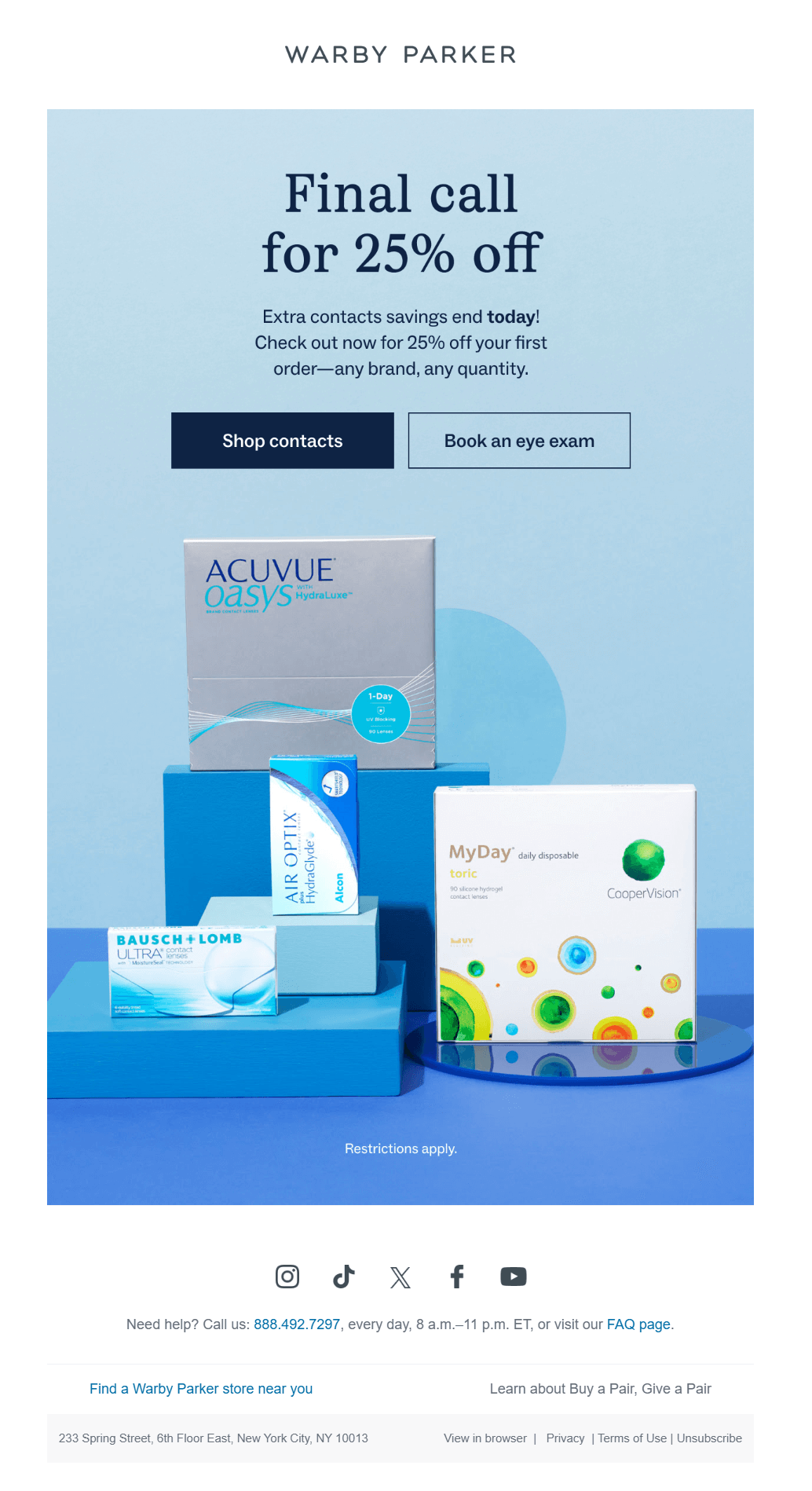
With clean visuals, bold CTAs, and a clear message (“Final call for 25% off”), they drive action fast. It’s a great example of using email to promote limited-time offers while keeping the design on-brand and easy to navigate.
Benefits of email marketing
Email marketing remains the go-to channel for building relationships, delivering value, and staying top of mind, all while providing you with the opportunity to convey more.
But that’s just the start. Email comes with more benefits, including:
- Scalable outreach: Reach thousands without a spike in costs.
- Flexible design: Add visuals, buttons, and brand elements to create engaging, on-brand messages.
- Smart automation: Set up behavior-based journeys that react to actions, preferences, or timing.
- Cost-efficiency: Get strong ROI with low setup and maintenance compared to other channels.
- Clear performance tracking: Measure opens, clicks, and conversions to optimize every send.
What is SMS Marketing?
SMS marketing is a form of direct marketing that uses text messages to communicate promotional, transactional, or time-sensitive information to customers. It’s a fast, personal, and highly effective way to reach people where they spend most of their time: their phones.
Here are some common SMS use cases:
- Flash sales & limited time offers: Notify subscribers instantly about exclusive deals or urgent promos.
- Appointment reminders: Reduce no-shows by sending timely reminders.
- Order & delivery updates: Keep customers in the loop with shipping confirmations and delivery tracking.
- Event notifications: Last-minute changes or alerts for registered attendees.
- Two-factor authentication (2FA): Secure logins and identity verification.
Transactional SMS marketing example
Netflix uses SMS to send timely and relevant messages, such as temporary access codes. It’s a great example of utility-focused SMS marketing, perfect for urgent, transactional communication.
Benefits of SMS Marketing
Whether you’re launching a flash sale or confirming a booking, this online marketing strategy helps you cut through the noise and connect with customers instantly.
- Fast results: Messages are delivered and read within minutes, making them ideal for urgent updates or time-sensitive offers.
- High engagement: SMS has high open and response rates, particularly on mobile devices.
- Simple & direct: No design or complex formatting is required.
SMS Marketing vs. Email Marketing: What are the Core Differences?
While both email and SMS marketing are powerful direct communication tools with numerous benefits and use cases, they serve different purposes and perform best in different scenarios.
Understanding how they differ will help you choose the right channel for your goals. Here’s an overview of their core differences:
| Email marketing | SMS marketing | |
| Engagement metrics | 20-30% open rate 4% CTR 3% conversion rate |
98% open rate 36% CTR 21-30% conversion rate |
| Content & format | No character limit Visuals and links CTAs & HTML layouts |
160 characters max No visuals (unless MMS) Plain text only |
| Cost & ROI | $1 per 10,000 emails ROI: $42 per $1 |
$1 per 20-100 SMS ROI: $71 per $1 |
| Compliance | CAN-SPAM & GDPR Flexible, but needs clean lists |
TCPA & CTIA Stricter consent rules, high penalties for violations |
| Intrusiveness | Less personal, but users tolerate frequent emails | More personal, but overuse feels spammy fast |
| Segmentation | Advanced (behavior, lifecycle, interests) | Basic tags, better with CRM integration |
| Personalization | Dynamic fields, tailored flows, subject lines | First name, promo codes, short links |
| Performance tracking | Opens, CTR, conversions, heatmaps, A/B testing | CTR via short links, opt-outs, response rates |
1. Opens, click-through and conversion rates
When it comes to performance metrics, email and SMS marketing show very different results, especially in how quickly users engage and convert.
Let’s break down how email marketing performs first:
- Open rate: Email marketing typically sees an average open rate of 20–30%, depending on the industry and quality of the list.
- Click-through rate (CTR): Across industries, the average CTR for email is around 4%.
- Conversion rate: Email campaigns generally see a conversion rate of around 3%, though this varies based on the type of content, industry, and audience segment.
SMS, on the contrary, presents the following:
- Open rate: SMS marketing has an open rate of up to 98%, with most messages opened within 3 minutes of delivery.
- Click-through rate (CTR): SMS sees an average CTR of 36%, significantly higher than most email campaigns.
- Conversion rate: SMS marketing delivers strong conversions, typically between 21–30% across industries. In the tech sector, conversion rates can reach as high as 40%.
2. Content elements and format
Now let’s compare email and SMS in terms of content and format.
Email gives you room to communicate with both depth and design, allowing for a richer brand experience.
- Character limit: Messages can be as long as needed.
- Tone: It can be promotional, educational, or conversational based on your needs.
- Visuals: Fully supported, including images, GIFs, logos, videos, and banners.
- CTA: Multiple CTAs (buttons, links, reply prompts) can be included.
- Branding elements: Full control over color schemes, typography, logos, and layout.
- Layout: HTML newsletter templates allow for structured formatting with headers, columns, and sections
Here’s an example from KUDU Coffee:
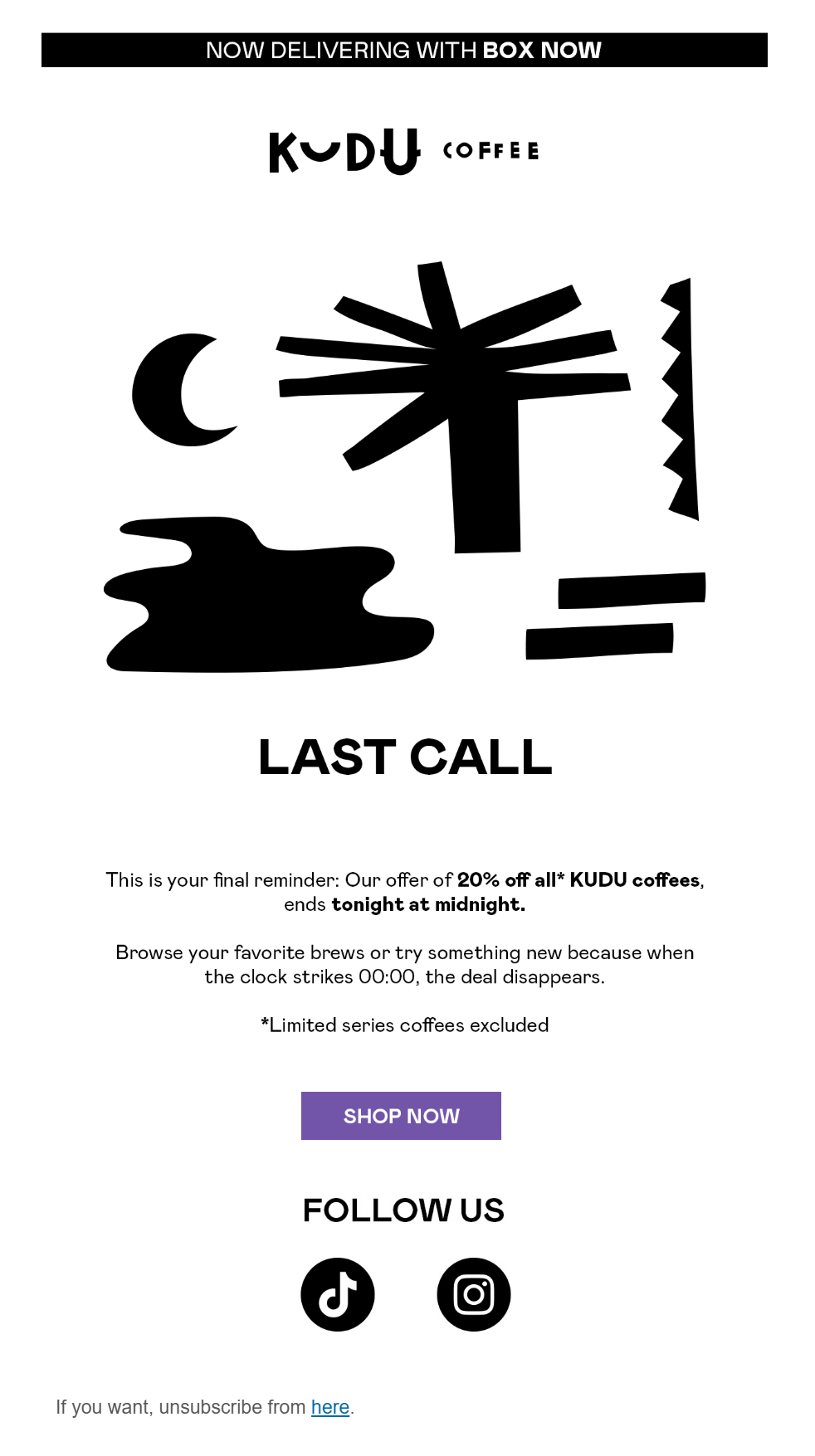
On the other hand, SMS messages are built for brevity and come with certain limitations.
- Character limit: Capped at 160 characters (including spaces) per message.
- Tone: Needs to be clear and action-focused due to limited space.
- Visuals: Not supported in standard SMS (MMS can include images but is more costly and less common).
- CTA: Usually one short link or instruction (e.g., “Click here,” “Reply yes/no”)
- Branding elements: Limited to sender ID and tone of voice.
- Layout: Plain text only. No formatting or styling
And here you can see KUDU Coffee’s SMS marketing campaign with a similar offer:
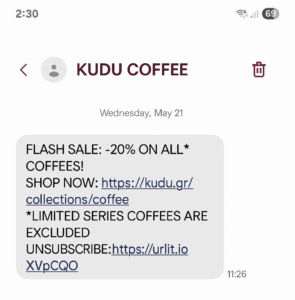
3. Cost and return on investment (ROI)
Email marketing is one of the most cost-effective channels available, especially when sending messages at scale.
- Cost per email: As low as $0.0001 per email (about $1 to send 10,000 emails).
- ROI: On average, email marketing delivers an ROI of $42 for every $1 spent.
- What impacts cost: Platform pricing tiers, number of contacts, email frequency, and advanced features like A/B testing or dynamic content
SMS marketing has a higher cost per message, but the tradeoff is immediacy and high engagement, especially for time-sensitive campaigns.
- Cost per SMS: Typically ranges from $0.01 to $0.05 per message. That means 20 to 100 SMS messages per $1.
- MMS Messages: Slightly more expensive; allow up to 1,600 characters and can include images, emojis, and short videos.
- International messaging: Costs vary based on provider and region, often $0.25 to $0.50 per international SMS.
- ROI: On average, SMS marketing delivers an impressive ROI of $71 for every $1 spent.
4. Deliverability and compliance
Email marketing is subject to international data privacy and anti-spam regulations. While the rules are firm, they offer more flexibility than SMS.
Key email regulations to consider:
- CAN-SPAM (US): Requires a clear opt-out, sender identification, and honest subject lines.
- GDPR (EU): Requires explicit consent and transparency on data usage.
Factors that affect email deliverability:
- Sender reputation (based on domain/IP history)
- Email content (spammy words, broken links)
- List hygiene (removing inactive or bounced contacts)
SMS is highly regulated, with stricter consent requirements and fewer chances for error. Violations can lead to hefty penalties or message blocking.
Key SMS regulations to consider:
- TCPA (US): Requires prior express written consent for promotional texts. Fines for non-compliance can range from $500 to $1,500 per message.
- CTIA Guidelines: Emphasize opt-in clarity, clear identification, and STOP instructions.
Factors affecting SMS delivery:
- Phone carriers may filter or block SMS campaigns that violate rules or appear spammy.
- High opt-out rates can reduce future deliverability.
5. Intrusiveness
Email tends to be a less intrusive channel, especially when subscribers have opted in for specific content types.
- Most users expect regular emails from brands they subscribe to, especially newsletters, promotions, or product updates.
- Audiences are generally tolerant of multiple emails per week as long as the content is relevant and personalized.
- Unsubscribing is easy and expected, making it important to offer a preference center or frequency options.
SMS is more direct, making it more powerful, but also more prone to feeling invasive if not handled with care.
- Text messages are often viewed as personal space, so recipients expect immediate value and clear relevance.
- Users are far less forgiving when it comes to SMS. Even one irrelevant or excessive message can lead to opt-outs or complaints.
6. Segmentation and personalization
Email is a powerhouse when it comes to personalization and audience targeting.
You can group your audience by demographics, such as age, gender, or location. It is also possible to segment based on:
- Behavioral triggers such as clicks, purchase history, or time spent on your site
- Lifecycle stages like onboarding, re-engagement, or loyalty
- Preferences and interests collected through sign-ups, surveys, or past interactions
To personalize your messages, you can use:
- Dynamic fields (first name, recent product viewed, birthday offers)
- Tailored subject lines and content blocks
- Automated flows triggered by user actions or inactivity
SMS can be personalized, but the level of segmentation depends on your tools and integrations.
For example, you can use basic targeting by list or campaign tags (e.g., VIPs, location-based offers). Advanced segmentation is possible, but only if connected to a CRM or customer data platform (CDP).
Compared to email personalization, SMS offers:
- Simple fields like first name, order number, or promo codes
- Short links personalized for tracking (e.g., unique coupons or landing pages)
Character limits and a lack of visual formatting make deep personalization more challenging. As a result, you have fewer opportunities to tell a full story or tailor long content.
7. Metrics and performance tracking
Email marketing provides actionable insights into how your audience interacts with your content.
Here are some of the email metrics that you can track:
- Open rates: Who opened your email and when
- Click-through rates (CTR): Which links and CTAs were clicked
- Bounce rates: Emails that failed to reach recipients
- Unsubscribe rates: Users opting out of your list
- Conversion tracking: Tied to goals like purchases, downloads, or signups
Advanced analytics let you dig deeper into performance with heatmaps to see where users click and scroll, A/B testing to optimize subject lines or content, and funnel tracking with ROI reporting through platform integrations.
SMS offers fewer metrics, but its simplicity makes results fast and clear, especially for short-term campaigns.
Here are some essential SMS metrics you can monitor:
- Delivery rates: Messages successfully sent and received
- Open rates: Often assumed to be high, though not always trackable
- CTR: Measured through shortened, trackable links
- Opt-out rates: Immediate insight into how messages are received
- Response rates: When two-way messaging is enabled (e.g., “Reply YES”)
Email Marketing and SMS Marketing: Pros & Cons
Above, we examined how email and SMS stack up across performance, cost, content, and more.
Now, let’s step back and examine the broader picture by evaluating the strategic advantages and disadvantages of each channel.
This will help you understand not just how they work but when and why to use them.
| Pros | Cons | |
| Email marketing |
|
|
| SMS marketing |
|
|
Email Marketing vs. SMS Marketing: When to Use Them
Knowing when to use email and SMS isn’t just about which channel performs better but how it’ll impact the customer journey.
Each channel fits different stages, and using them strategically is what turns communication into conversion.
When to use email marketing
Email excels when you need to guide users through a more complex decision-making process.
It’s best suited for:
- Product launches or detailed updates: Ideal for showcasing features, benefits, and images in a branded layout.
- Educational content or lead nurturing: Whether it’s onboarding, content series, or newsletters, email lets you build trust over time.
- Seasonal campaigns and promotions: Use email to warm up your audience before major shopping events, such as Black Friday with visual campaigns and early access.
- Creating a branded experience: With design control, you can fully align emails with your brand’s voice, visuals, and tone.
When to use SMS marketing
SMS is your go-to for moments when speed, visibility, and action are essential.
Brands use it to:
- Trigger real-time responses: Perfect for flash sales, limited-time discounts, or back-in-stock alerts where every second counts.
- Re-engage customers quickly: Win back inactive users or nudge cart abandoners with a short, compelling message.
- Send reminders or updates: Great for appointment confirmations, event reminders, or shipping notifications that need to land fast.
- Cut through the noise: When inboxes are crowded, a well-timed SMS can be the difference between being seen or skipped.
How to Choose the Right Channel for Your Business
Deciding between email and SMS marketing comes down to budget, goals, context, and customer behavior.
While there’s no one-size-fits-all answer, the following factors can help you make the right choice for your business.
Your budget
Email is significantly more cost-effective for large-scale messaging. If you’re sending frequent campaigns or have a growing list, email offers high ROI with minimal send costs.
SMS, while more expensive per message, pays off when speed and engagement are the priority, especially for targeted, short-term campaigns.
Campaign message
When planning your campaign, ask yourself: does this message need room to tell a story or just a quick nudge?
If you’re sharing product launches, detailed guides, or content-rich updates, email is the better fit. For time-sensitive alerts, reminders, or flash offers, SMS is more likely to drive fast action. Matching the message to the medium makes all the difference.
Audience preferences and behavior
Audience preferences and behavior matter. Some people check their inbox daily, while others respond better to quick texts.
Use your data, such as open rates, response times, and device type, to see how your audience prefers to engage and tailor your channel strategy accordingly.
Mobile vs. desktop usage
If your audience is mobile-first, SMS can help you reach them instantly where they are.
Email can still work well on mobile, but it requires responsive design and shorter formats to be effective on smaller screens.
Your marketing tools
Some tools support both email and SMS, while others don’t.
Consider what your current marketing platform allows. Integrated systems that let you build unified workflows will make combining channels easier and more effective.
Final Verdict: Email or SMS?
If you’re still debating which channel is better, the truth is you don’t have to pick just one.
Email gives you the space to build brand loyalty and guide customers through complex decisions. SMS cuts through the noise when timing matters, delivering urgency with a tap.
To use them effectively, think of them as teammates, not duplicates. Here’s how a B2C brand can use both in tandem:
- Email: After a customer places an order, the store sends a branded confirmation email with order details, expected delivery dates, and links to support or upsells.
- SMS: Two days after the order ships, the customer receives a short text message with the tracking link. This is a time-sensitive update they’re likely to check on their phone.
The result is a smooth, engaging experience that meets the customer where they are, with the right message, in the right format, and at the right time.
Just remember that while using both channels often drives the best results, it’s not always necessary. If your audience responds better to one, or if the message only fits one format, go with what works.
The real win is using each channel when it fits, based on the message, the moment, and your customer.
Best Practices for Combining Email and SMS Marketing
Using email and SMS can level up your marketing game, but only if done with strategy.
Choose tools that integrate with each other
If you’re just starting out or want to keep your messaging streamlined, consider using a platform that offers both email and SMS under one roof.
Many modern email marketing and marketing automation tools now include SMS capabilities or plan to do so due to rising demand. This will make it easier than ever to manage both from a single dashboard.
This setup gives you:
- Unified campaign tracking
- Easy cross-channel automation
- Consistent audience segmentation
If you’re using a standalone email platform like Moosend, you can still add SMS by connecting it with platforms like Postscript, Yotpo or Attentive. With Zapier or built-in integrations, you can sync your email and SMS data, automate workflows, and create a smooth cross-channel experience without switching platforms.
Use triggers to coordinate timing
One of the biggest mistakes you can make is sending the same message on both channels simultaneously. Instead, set up automated flows with clear timing and purpose.
For example, send an email with a discount offer, then follow up with an SMS reminder a day before it expires. Or send an SMS for a delivery update, then follow up with an email that includes a how-to guide or customer support info.
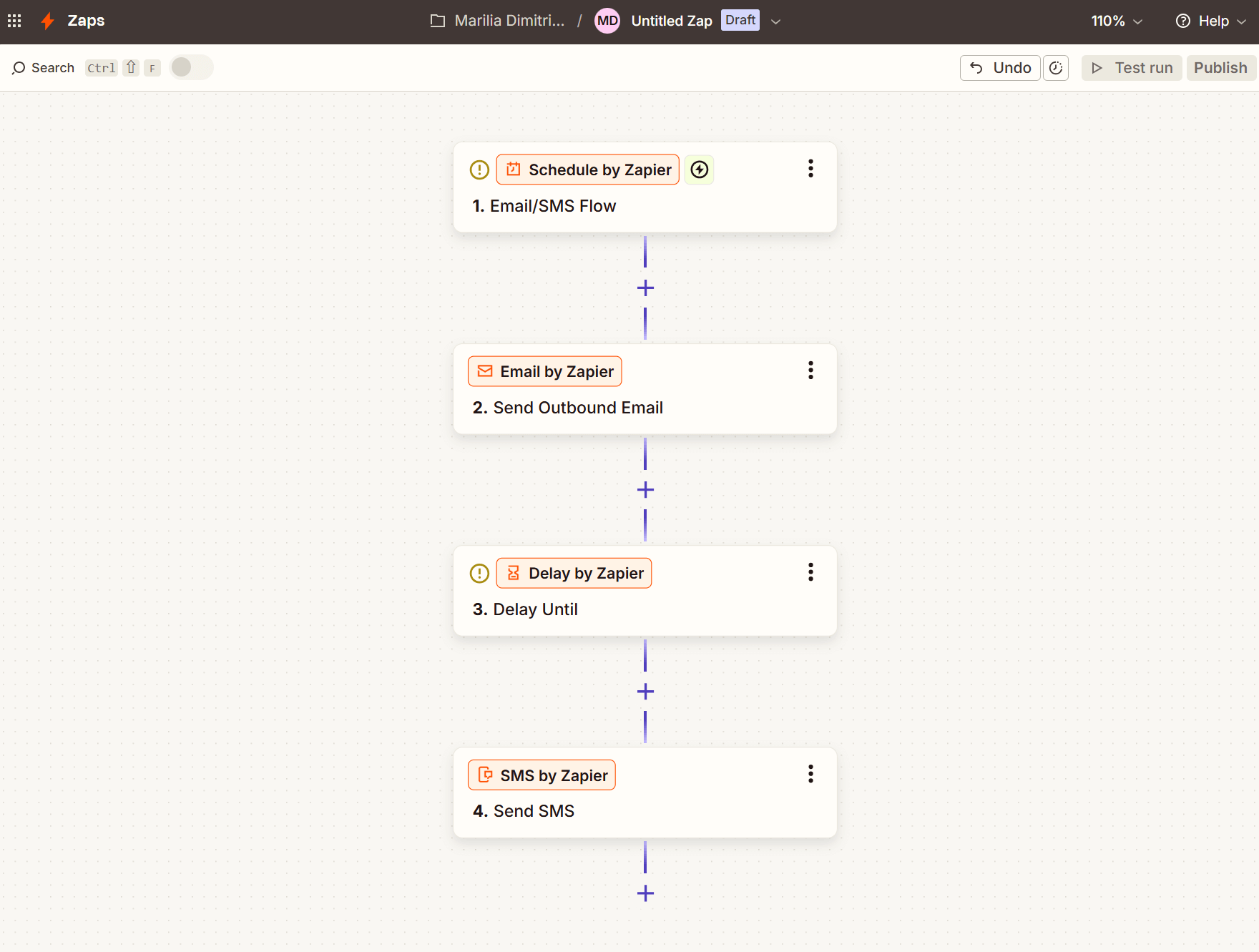
If your email platform integrates with SMS tools through Zapier or native connections, you can build these flows easily.
Use triggers such as “email opened,” “link clicked,” or “purchase made” to initiate the next message in the journey.
Segment your audience
Not everyone wants to hear from you the same way. Use a preference center to allow subscribers to choose their preferred channel: email, SMS, or both. Then, track behavior to refine your segments, such as who clicks emails, who replies to texts, and who ignores both.
Aligning with audience preferences and actual behavior ensures your messages stay relevant, timely, and welcome.
Weruva’s email is a great example of letting users choose their preferred communication channel. It also asks what type of content they prefer, from promos to education.
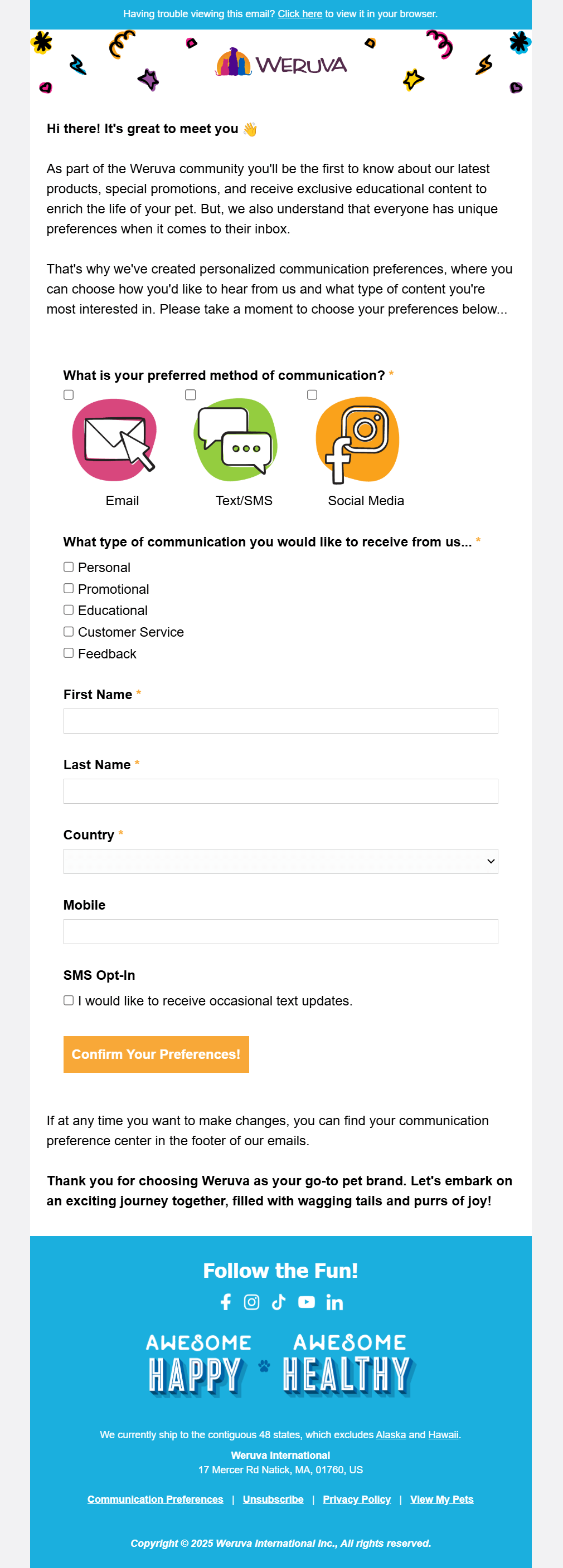
This simple form keeps their audience in control and improves engagement by sending the right messages through the right channels.
Monitor campaign performance
To run effective cross-channel campaigns, you need to keep an eye on how each channel performs.
Track key metrics like open rates, click-throughs, conversions, and opt-outs side-by-side to understand what’s working and what’s not.
The best thing to do is to find patterns. Is one channel driving more conversions early in the funnel? Are people opting out after receiving too many messages in a short span? Use this data to tweak your timing, frequency, and messaging mix.
The goal is to have enough touchpoints to stay top-of-mind without overwhelming your audience.
Follow compliance rules for opt-ins and messaging
Always respect regulations like GDPR, CAN-SPAM, and TCPA. Get clear consent before sending messages, include opt-out options, and stay transparent about how you use customer data.
This protects your business from fines, keeps your credibility intact, and helps your emails and texts land where they should.
Email Marketing vs. SMS Marketing: Both Win
Email and SMS marketing aren’t rivals but partners.
While email excels at storytelling, automation, and brand-building, SMS delivers immediacy and high engagement for time-sensitive messages. Instead of choosing one, smart marketers combine both to maximize reach and ROI.
Start by understanding your audience, tailoring content to the right channel, and using segmentation to avoid fatigue.
Ready to boost results? Start building your email and SMS flows today. And if you need a reliable email tool to create your email campaigns, you can sign up for a free Moosend account today.
FAQs
Below, let’s answer some common questions regarding email and SMS marketing.
1. Is email better than SMS?
It depends on your goals. Email is better for detailed content, storytelling, and automation, perfect for nurturing leads and building brand experiences. SMS, on the other hand, is better for urgent updates and high engagement in the moment. The best strategy is often using both, each where it performs best.
2. Compared to SMS, what does email allow marketers to do better?
Email allows marketers to create richer, longer messages with visuals, links, and branded designs. It also supports advanced segmentation, A/B testing, automation flows, and detailed analytics, making it a go-to for long-term engagement strategies.
3. Which is faster, SMS or email?
SMS is faster when it comes to reach and response. Most text messages are opened within 3 minutes, making it ideal for flash sales, reminders, and urgent updates. Email, while quick, doesn’t usually get the same immediate open rate.
4. Which is more effective, text or email?
Effectiveness depends on the context. Text messages often see higher open and click-through rates, but email drives stronger results for in-depth content and long-term ROI. Use SMS for urgent matters and email for in-depth communication. Together, they’re a powerful combo.
5. Is SMS outdated?
Not at all. If anything, SMS is more relevant than ever, especially for time-sensitive alerts and mobile-first audiences. When used wisely and with consent, SMS can drive impressive engagement and conversions across industries.



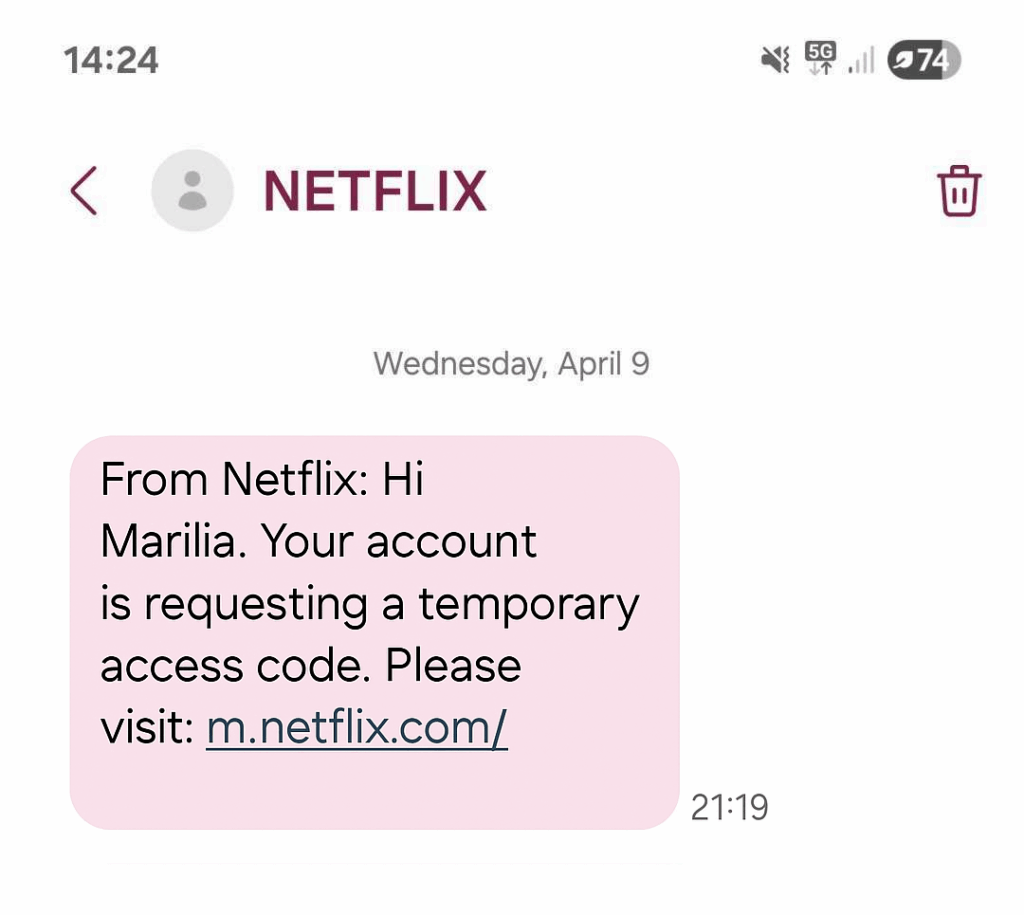

 Published by
Published by

 Published by
Published by
